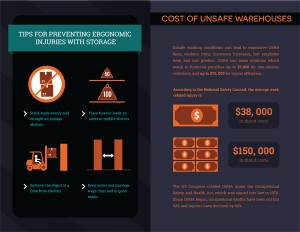 Warehouses, manufacturing facilities and other material handling operations are busy places. There are constantly vehicles and people moving around, often sharing the same space. If proper warehouse safety protocols aren’t in place, it can easily lead to an accident which can cause lost product, property damage, personal injury or even death.
Warehouses, manufacturing facilities and other material handling operations are busy places. There are constantly vehicles and people moving around, often sharing the same space. If proper warehouse safety protocols aren’t in place, it can easily lead to an accident which can cause lost product, property damage, personal injury or even death.
If there’s a serious accident in your facility, you can expect a visit from inspectors of the US Occupational Safety and Health Administration. Depending on their findings, you could face fines and possibly even criminal prosecution. Then there’s civil suits, workmen’s compensation claims, lost employee productivity and even the replacement costs for lost and damaged products to consider.
Add it all up and it becomes clear that promoting safe operations is a better option for ensuring the productivity and profitability of your business.
OSHA was created in 1970 by the US Congress as part of the Occupational Safety and Health Act that was signed into law by then-President Richard Nixon. Since then, it has helped reduce fatal workplace accidents by 62% per year. And worker injuries have been reduced by 42%.
If OSHA inspectors determine that you are responsible for an accident or injury within your facility, the agency can issue citations that can result in financial penalties of up to $7,000 for each non-serious violation and up to $70,000 for each repeat offense. With that kind of money, fines can do serious damage to your bottom line.
According to the National Safety Council, the average work-related injury resulted in $150,000 in indirect costs and $38,000 in direct costs. There aren’t very many companies that can afford to absorb nearly $200,000 in costs if an injury accident occurs.
Among the most common type of accidents are those that result in muscle damage to workers, such as back injuries from lifting improperly. In order to help prevent these types of injuries in your workplace, here are some tips for preventing ergonomic injuries:
1. Stack Loads Evenly and Straight on Storage Shelves — Whether a load will tip or not is determined by its center of gravity. When you stack loads evenly and straighten boxes so they are straight on storage shelves, it helps lower the center of gravity so that stability is maintained and it’s less likely to tip over.
2. Place Heavier Loads on Lower or Middle Shelves — Placing heavier loads on top of lighter loads raises the overall load’s center of gravity. When the center of gravity is higher, the stability of the load is threatened. Place heavier objects on lower shelves in order to prevent tipped and spilled loads.
3. Remove Objects from Shelves One at a Time — Trying to work too quickly and take shortcuts such as removing multiple objects from shelves simultaneously increase the risk of accident. Slow down and do it right the first time.
4. Keep Aisles and Passageways Clear — Although warehouses are busy places, it’s important that aisles be kept clear and in good repair at all times. Regularly check your passageways and aisles to make sure they are clear of blockages. Train your workers to do the same and you can substantially reduce the risk of accidents.
